ANSWER ALL THE QUESTIONS

QUESTIONS
-
-
- The grid below represents part of the period table. Study the information in it and answer the questions that follow. The letters do not represents the actual symbols of the elements.

- Select an element that can form an ion with a change of -2. Give a reason for your answer. (2mks)
- What type of structure would the oxide of G have? (1mk)
- How does the reactivity of H and E compare? Give a reaction for your answer. (2mks)
- 1.3g of B reacts completely when heated in 1.2 litres of chlorine gas at s.t.p (molar gas volume at s.t.p is 22.4litres)
- Write an equation for the reaction between B and chlorine (1mk)
- Determine the relative atomic mass of B. (2mks)
- Explain how you would expect the following to compare
- Atomic radius of F and B. (2mks)
- The PH value of the aqueous solution of the oxide of B and D. (2mks)
- The grid below represents part of the period table. Study the information in it and answer the questions that follow. The letters do not represents the actual symbols of the elements.
- Study the information below and answer the questions (the letters do not represent the actual symbols of the elements.
elements
Electronic configuration
IE (kj/mol)
I
2.1
519
K
2.8.1
494
L
2.8.8.1
418
- What is Ionizations? (`1mk)
- Explain why element L has the lowest Ionizations energy. (1mks)
- Write an equation for the reaction between K and water. (1mk)
- Using dots(.) and cross (x) show the bonding in the compound between I and Chlorine (1mk)
-
- The flow chart below shows the stages involved in manufacture of H2SO4 acid by contact process. Study it and answer that questions that follow.
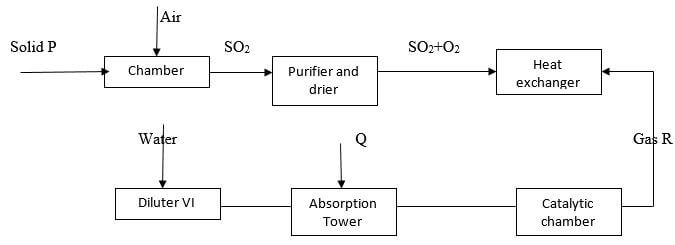
- A part from sulphur, identify other substance that can be used as a Solid P. (1mk)
- What is the function of the purifier? (1mk)
- Give two functions of the heat exchanger. (1mk)
- State the optimum conditions for the reaction to take place at the catalytic chamber. (1mk)
- Name
- Gas R. (1mk)
- Substance Q. (1mk)
- Write equations for the reaction taking place at the-;
- Catalytic chamber. (1mk)
- Absorption tower. (1mk)
- Explain why Gas R cannot be dissolved in water to form sulphuric (VI) acid. (1mk)
- Exhaust gases this process are passed through Chimneys lined with calcium hydroxide to avoid pollution.
- Name this process. (1mk)
- Write the equation for the reaction taking place. (1mk)
- State the observation made when concentrated Sulphuric (VI) acid is poured into a beaker containing sugar crystals. Name the property of conc sulphuric acid. (1mk)
-
- What is an unsaturated hydrocarbon compound (1mk)
- The scheme below shows a series of reactions starting with propanol. Study it and answer the questions that follow.
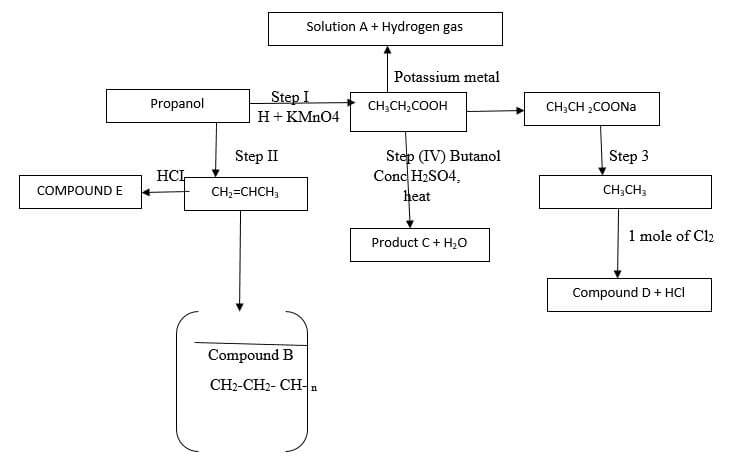
- Name the type of reaction in step I and II (2mks)
- Write the equation for the reaction that takes place in Step III (1mks)
- Name the substance labelled A, C, D and E. (2mks)
- Draw the structural formula of product C (1mk)
- Name the process in step (IV) (1mk)
- Name compound B and state the type of reaction involved in its formation. (2mks)
- If the relative molecular mass of B is 35,700 determine the value of n. (2mks)
-
- Acidified potassium Manganate (VII) solution oxidises Iron (ii) to Iron (III) as shown in the Ionic equation below. If 0.2M KMno4 solution is needed to react with 25cm3 of 0.1M Iron (II) ammonium Sulphate, Calculate the volume of KMno4 solution required. (3mks)
MnO4-(aq) + 5Fe2+(aq) + 8H+(aq) → Mn2+(aq) + 4H2O (l) + 5Fe3+(aq) - 12g of a mixture of sodium Sulphate and Sodium Carbonate were mixed with distilled water in a flask and topped up to 100cm3. 25cm3 of this solution required 12.5cm3 of 0.2M Sulphuric (VI ) acid for complete reaction.
- Write down the chemical equation for the reaction that occurred between the mixture and Sulphuric (VI) acid . (1mk)
- Calculate the number of moles of H2SO4 which reacted with the mixture. (2mks)
- Determine the number of moles of the substances in the mixture that reacted with H2SO4 (2mks)
- Determine the molarity of the substance in C above. (2mks)
- What was the mass of Sodium Carbonate in the mixture? (2mks)
- What was the percentage of Sodium Sulphate in Mixture. (2mks)
- Acidified potassium Manganate (VII) solution oxidises Iron (ii) to Iron (III) as shown in the Ionic equation below. If 0.2M KMno4 solution is needed to react with 25cm3 of 0.1M Iron (II) ammonium Sulphate, Calculate the volume of KMno4 solution required. (3mks)
-
- What is meant by molar heat of neutralization (1mk)
- State Hess’s law. (2mks)
- Given the following molar heat of combustion of graphite, hydrogen and anthracene as
ΔHºC (graphite) = -394 kj/mol
ΔHºC(N2) = -286Kj/mol
ΔHºC(C14H10) = -7114 kj/mol- Write down the equation for formation of anthracene (1mks)
- Draw an energy cycle diagram that links heat of formation of anthracene with heat of combustion of hydrogen, graphite and anthracene (3mks)
- Calculate the standard heat of formation of anthracene. (2mks)
- When excess Iron fillings were added to 25.0cm3 of 0.4M Copper (ii) Sulphate solution, temperature rose by 15.0ºC. Other than rise in temperature,
- State and explain any other observation made. (2mks)
- Determine the molar heat change (C=4.2 J.gK- density of water=1g/cm3. (3mks)
- Draw an energy level diagram to represent the above reaction. (2mks)
- Consider the following reaction at equilibrium
- PCl5 (g)
 PCl3(g)+ Cl2(g)
PCl3(g)+ Cl2(g) - Complete the table to show the effect of different factors on the position of equilibrium.
Factor
Effect on Equilibrium position
i) Decrease in pressure
(1mks)
ii) Removing Chlorine
(1mks)
iii) Adding Helium to the mixture
(1mks)
- Ammonia can be converted to nitrogen (ii) Oxide as shown in the equation below.
4NH3(g) + 5O2(g) 4NO(g) + 6H2O (g)
4NO(g) + 6H2O (g)- Explain how on increase in temperature would affect the yield of Nitrogen (II) Oxide. (2mks)
- On the energy level diagram below, sketch the energy level diagram that would be obtained if the reaction is carried out in the presence of a platinum catalyst (2mks)
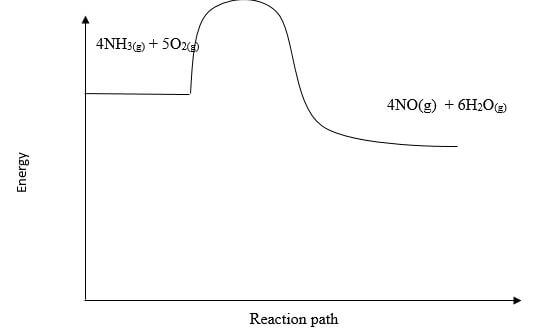
- The reaction below is in equilibrium
Br2(aq) + H2O(i) OBr- + Br- +2H+
OBr- + Br- +2H+ -
- State and explain the effect on the equilibrium when the dilute hydrochloric acid is added. (2mks)
- What is the effect of increasing hydrogen and Chlorine? Explain. (2mks)
H2(g) + Cl2(g) 2Hcl(g)
2Hcl(g)
- PCl5 (g)

MARKING SCHEME
-
-
- The grid below represents part of the period table. Study the information in it and answer the questions that follow. The letters do not represents the actual symbols of the elements.

- Select an element that can form an ion with a change of -2. Give a reason for your answer. (2mks)
A - reacts by gaining 2 electrons - What type of structure would the oxide of G have? (1mk)
Giant ionic structure - How does the reactivity of H and E compare? Give a reaction for your answer. (2mks)
E is more reactive than H/H is less reactive than E. E can easily gain electron/ E has a higher electron affinity than H/ E is more electronegative than H
- Select an element that can form an ion with a change of -2. Give a reason for your answer. (2mks)
- 1.3g of B reacts completely when heated in 1.2 litres of chlorine gas at s.t.p (molar gas volume at s.t.p is 22.4litres)
- Write an equation for the reaction between B and chlorine (1mk)
B(s) + Cl2(g) → BCl2 // Mg (s) + Cl2(g) → MgCl2(s) - Determine the relative atomic mass of B. (2mks)
22.4 L → 1 mole
1.2l → ?
1.2 x 1
22.4
= 0.05357
mole ratio 1:1
mole of B → 0.05357
1.3 g → 0.05357 → 1 mole
1.3 x 1
0.05357
= 24.2673
- Write an equation for the reaction between B and chlorine (1mk)
- Explain how you would expect the following to compare
- Atomic radius of F and B. (2mks)
F has a larger atomic radius than B / B has a smaller atomic radius than F. B has more protons than F thus higher nuclear charge force of attraction - The PH value of the aqueous solution of the oxide of B and D. (2mks)
B solution has a PH above 7 while D solution has PH below 7
- Atomic radius of F and B. (2mks)
- The grid below represents part of the period table. Study the information in it and answer the questions that follow. The letters do not represents the actual symbols of the elements.
- Study the information below and answer the questions (the letters do not represent the actual symbols of the elements.
elements
Electronic configuration
IE (kj/mol)
I
2.1
519
K
2.8.1
494
L
2.8.8.1
418
- What is Ionizations? (`1mk)
It is the minimum energy required to remove the outermost electrons of an isolated gaseous system - Explain why element L has the lowest Ionizations energy. (1mks)
L - has the largest atomic radius - Write an equation for the reaction between K and water. (1mk)
2K(s) + 2H2O(l) → 2KOH (aq) + H2(g) - Using dots(.) and cross (x) show the bonding in the compound between I and Chlorine (1mk)

- What is Ionizations? (`1mk)
-
- The flow chart below shows the stages involved in manufacture of H2SO4 acid by contact process. Study it and answer that questions that follow.

- A part from sulphur, identify other substance that can be used as a Solid P. (1mk)
Zn blende / ZnS, Galena / PbS, copper pyrite/ CuFeS2 - What is the function of the purifier? (1mk)
To remove impurities which may poison the catalyst - Give two functions of the heat exchanger. (1mk)
To raise the temperature of the reacting gases (SO2 + O2)
To lower the temp of SO3 - State the optimum conditions for the reaction to take place at the catalytic chamber. (1mk)
Catalysts Vanadium (V) Oxide (V2O5), pressure 2-3 atm
Temperature 450ºC - Name
- Gas R. (1mk)
Sulphur (IV) oxide - Substance Q. (1mk)
Conc. Sulphuric (vi) acid
- Gas R. (1mk)
- Write equations for the reaction taking place at the-;
- Catalytic chamber. (1mk)
2SO2(g) + O2(g) → 2SO3(g) - Absorption tower. (1mk)
H2SO4(l) + SO3(g) → H2S2O7(l)
- Catalytic chamber. (1mk)
- Explain why Gas R cannot be dissolved in water to form sulphuric (VI) acid. (1mk)
Reacting is highly exothermic thus the acid formed boils to form a mist of fine droplets of sulphuric acid in air - Exhaust gases this process are passed through Chimneys lined with calcium hydroxide to avoid pollution.
- Name this process. (1mk)
scrubbing - Write the equation for the reaction taking place. (1mk)
Ca(OH)2 + SO2(g) → CaSO3(s) + H2O (l)
- Name this process. (1mk)
- State the observation made when concentrated Sulphuric (VI) acid is poured into a beaker containing sugar crystals. Name the property of conc sulphuric acid. (1mk)
Black solid is formed/ sugar turns from brown to black
dehydrating agaent
- A part from sulphur, identify other substance that can be used as a Solid P. (1mk)
-
- What is an unsaturated hydrocarbon compound (1mk)
are carbons with high carbon hydrogen ratio and burn with yellow sooty flame - The scheme below shows a series of reactions starting with propanol. Study it and answer the questions that follow.

- Name the type of reaction in step I and II (2mks)
step r → oxidation
step II → dehydration - Write the equation for the reaction that takes place in Step III (1mks)
CH3CH2COONa + NaOH → CH3CH3 + Na2CO3 - Name the substance labelled A, C, D and E. (2mks)
A - potassium propanoate
C - butyl propanoate
D - chloroethane
e - chloropropane or 2 - chloropopane - Draw the structural formula of product C (1mk)

- Name the process in step (IV) (1mk)
esterification - Name compound B and state the type of reaction involved in its formation. (2mks)
polypropene
polymerisation - If the relative molecular mass of B is 35,700 determine the value of n. (2mks)

= 42
35700
42
= 850
- Name the type of reaction in step I and II (2mks)
- What is an unsaturated hydrocarbon compound (1mk)
-
- Acidified potassium Manganate (VII) solution oxidises Iron (ii) to Iron (III) as shown in the Ionic equation below. If 0.2M KMno4 solution is needed to react with 25cm3 of 0.1M Iron (II) ammonium Sulphate, Calculate the volume of KMno4 solution required. (3mks)
MnO4-(aq) + 5Fe2+(aq) + 8H+(aq) → Mn2+(aq) + 4H2O (l) + 5Fe3+(aq)
mass of itron compund = 25 x 0.1
1000
= 0.0025 moles
0.2 moles is in 1000cm3
0.0025 moles => ?
0.0025 x 1000 = 12.5 cm3
0.2 - 12g of a mixture of sodium Sulphate and Sodium Carbonate were mixed with distilled water in a flask and topped up to 100cm3. 25cm3 of this solution required 12.5cm3 of 0.2M Sulphuric (VI ) acid for complete reaction.
- Write down the chemical equation for the reaction that occurred between the mixture and Sulphuric (VI) acid . (1mk)
H2SO4(aq) + Na2CO3(aq) → Na2SO4(aq) + CO2(g) + H2O(l) - Calculate the number of moles of H2SO4 which reacted with the mixture. (2mks)
moles = molarity s volume (cm3)
1000
12.5 x 0.25 = 0.003125
1000 - Determine the number of moles of the substances in the mixture that reacted with H2SO4 (2mks)
mole vector is 1:1
= 0.003125 moles - Determine the molarity of the substance in C above. (2mks)
molarity = No. moles x 1000
volume in (cm3)
0.003125 x 1000 = 0.125 M
25 - What was the mass of Sodium Carbonate in the mixture? (2mks)
mass = moles x RFM
? = 0.003125 x 106
= 0.33 g - What was the percentage of Sodium Sulphate in Mixture. (2mks)
(12g - 0.33) = 11.67g
11.67g x 100% = 97.25%
12g
- Write down the chemical equation for the reaction that occurred between the mixture and Sulphuric (VI) acid . (1mk)
- Acidified potassium Manganate (VII) solution oxidises Iron (ii) to Iron (III) as shown in the Ionic equation below. If 0.2M KMno4 solution is needed to react with 25cm3 of 0.1M Iron (II) ammonium Sulphate, Calculate the volume of KMno4 solution required. (3mks)
-
- What is meant by molar heat of neutralization (1mk)
this is the heat energy released when one mole of water is formed from a reaction between an acid and an alkali - State Hess’s law. (2mks)
the energy changes in converting reactants to product is the same regardless of the route by which the chemical changes occurs - Given the following molar heat of combustion of graphite, hydrogen and anthracene as
ΔHºC (graphite) = -394 kj/mol
ΔHºC(N2) = -286Kj/mol
ΔHºC(C14H10) = -7114 kj/mol- Write down the equation for formation of anthracene (1mks)
14C(s) + 5H2(g) → C14H10(g) - Draw an energy cycle diagram that links heat of formation of anthracene with heat of combustion of hydrogen, graphite and anthracene (3mks)
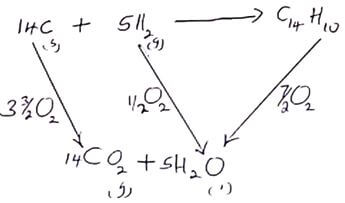
- Calculate the standard heat of formation of anthracene. (2mks)
ΔHcC + ΔHcII2 - ΔHcC14H10 = ΔHfC14H10
14(-394) + 5(-286) -(-7114) = x
-5516 + -1430 = x + - 7114
(-6946 + 7114)
= + 168 kjmol
- Write down the equation for formation of anthracene (1mks)
- What is meant by molar heat of neutralization (1mk)
- When excess Iron fillings were added to 25.0cm3 of 0.4M Copper (ii) Sulphate solution, temperature rose by 15.0ºC. Other than rise in temperature,
- State and explain any other observation made. (2mks)
red brown solid deposits, copper ion oxidises to copper metal
colour changes from blue to light green because hydrated CO2+ ions are removed and replaced with Fe2+ ions - Determine the molar heat change (C=4.2 J.gK- density of water=1g/cm3. (3mks)
ΔH = McΔT
=(25 x x4.2 x 15k)
= 15.75 J
0.01 → 1575
1 → x
x = -157.5 Kjmol - Draw an energy level diagram to represent the above reaction. (2mks)
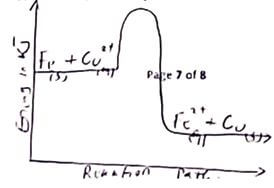
- State and explain any other observation made. (2mks)
- Consider the following reaction at equilibrium
- PCl5 (g)
 PCl3(g)+ Cl2(g)
PCl3(g)+ Cl2(g) - Complete the table to show the effect of different factors on the position of equilibrium.
Factor
Effect on Equilibrium position
i) Decrease in pressure
equilibrium shifts to the right
foward reaction favouredii) Removing Chlorine
Equilibriums shifts to the right
foead reaction favourediii) Adding Helium to the mixture
no effect - helium is inert
- Ammonia can be converted to nitrogen (ii) Oxide as shown in the equation below.
4NH3(g) + 5O2(g) 4NO(g) + 6H2O (g)
4NO(g) + 6H2O (g)- Explain how on increase in temperature would affect the yield of Nitrogen (II) Oxide. (2mks)
the reaction is exothermic hence increases in temperature would lower the yield of nitrogen (II) oxide - On the energy level diagram below, sketch the energy level diagram that would be obtained if the reaction is carried out in the presence of a platinum catalyst (2mks)

- Explain how on increase in temperature would affect the yield of Nitrogen (II) Oxide. (2mks)
- The reaction below is in equilibrium
Br2(aq) + H2O(i) OBr- + Br- +2H+
OBr- + Br- +2H+ -
- State and explain the effect on the equilibrium when the dilute hydrochloric acid is added. (2mks)
H+ ions are introduced which react with colourless bromide and hypobromide ions to form yellow - orange aqueous bromine equilibrium shifts from right to left
backward reaction favoured - What is the effect of increasing hydrogen and Chlorine? Explain. (2mks)
H2(g) + Cl2(g) 2Hcl(g)
2Hcl(g)
No effect on the yield of hydrogen chloride. The number of molecules of reactants equals the number of molecules of products
- State and explain the effect on the equilibrium when the dilute hydrochloric acid is added. (2mks)
- PCl5 (g)
Download Chemistry Paper 2 Questions and Answers - Form 4 Term 2 Opener Exams 2022.
Tap Here to Download for 50/-
Get on WhatsApp for 50/-
Why download?
- ✔ To read offline at any time.
- ✔ To Print at your convenience
- ✔ Share Easily with Friends / Students

